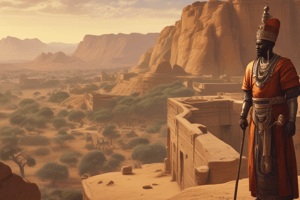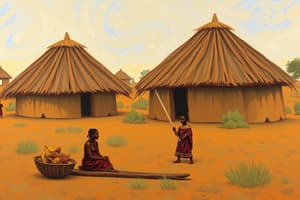Podcast
Questions and Answers
What geographical feature primarily hindered communication and unity among the forest states of West Africa in the 15th century?
What geographical feature primarily hindered communication and unity among the forest states of West Africa in the 15th century?
- Dense tropical forests, coupled with dangerous cascading rivers. (correct)
- Vast savannah grasslands that promoted nomadic lifestyles.
- A lack of navigable rivers for transporting goods and people.
- Extensive deserts that isolated communities.
How did the environmental conditions influence the socio-political structures of West African societies in the 15th century?
How did the environmental conditions influence the socio-political structures of West African societies in the 15th century?
- The savannah fostered large, unified empires, while the forests led to fragmented states. (correct)
- The desert encouraged centralized governance due to the scarcity of resources.
- The tropical forests promoted maritime trade and coastal dominance.
- The grasslands supported egalitarian societies due to ease of communication.
What was a significant difference between the Savannah and Tropical forest regions in West Africa during the 15th century?
What was a significant difference between the Savannah and Tropical forest regions in West Africa during the 15th century?
- The Savannah lacked developed trade routes, while the Tropical forest had extensive river networks.
- The Savannah region consisted of large empires, while the Tropical forest consisted of smaller forest states. (correct)
- The Savannah worshipped one God, while the Tropical forest consisted of polytheistic worshippers.
- The Savannah region was primarily agricultural, while the Tropical forest region focused on trade.
How did the commencement of the slave trade in the 15th century potentially impact the existing differences between the Savannah and forest-based African societies?
How did the commencement of the slave trade in the 15th century potentially impact the existing differences between the Savannah and forest-based African societies?
Which geographical factor most directly contributed to the development of large empires in the Sudan/Savannah region of West Africa?
Which geographical factor most directly contributed to the development of large empires in the Sudan/Savannah region of West Africa?
Flashcards
Savannah region
Savannah region
A grassland area between forests and deserts in West Africa.
Three empires
Three empires
Ghana, Mali, and Songhai; developed in West Africa from AD 800 to 1600.
Forest states
Forest states
Political entities like Benin, Oyo, Dahomey, and Asante found in tropical forests.
Communication barriers
Communication barriers
Signup and view all the flashcards
Slave trade impact
Slave trade impact
Signup and view all the flashcards
Study Notes
West African Societies in the 15th Century
- West Africa, from the forest south to the desert north, featured a savannah region where empires like Ghana, Mali, and Songhai thrived (800-1600 AD).
- A tropical forest region lies 150-300 km from the coast, with limited connectivity due to dangerous rivers and limited footpaths, isolating communities.
- Forest states like Benin, Oyo, Dahomey, and Asante existed within this region.
- Distinct skills, technologies, and political structures existed between savannah and forest peoples at the start of the 15th-century slave trade.
Studying That Suits You
Use AI to generate personalized quizzes and flashcards to suit your learning preferences.




